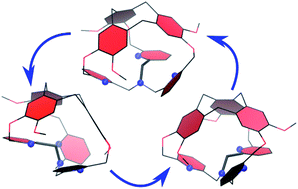The key features that govern the chirality transfer in a structurally contracted covalent cage, consisting of a northern chiral cyclotriveratrylene (CTV) connected to a southern tris(2-pyridyl-methyl)amine (TPA) unit by three methyl bridges, are described. The preferential orientation of the propeller arrangement of TPA is dictated by its compact structure, with an arm of the TPA unit pointing inside the cage, together with the relative positioning of the three pyridines regarding the chiral CTV cap. The diastereomers with P/P (or M/M) configurations for the CTV and TPA units adopt eclipsed structures and were found to be more stable by 40 kJ mol−1 than the P/M (or M/P) diastereomer which displays a staggered arrangement. The existence of isomerization pathways between isomers of the cage with low energy barriers (38 kJ mol−1) accounts for the 1H-NMR signal, which is consistent with an averaged C3 structure.

